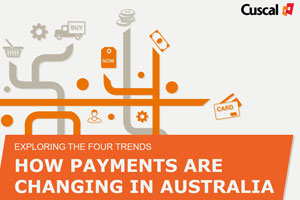
With Australia’s New Payments Platform (NPP) still around two years from starting it would be easy to assume that financial institutions still have plenty of time to get ready, but the reality is that time is rapidly running out. Financial institutions that get ready now will receive clear economic benefits – those that don’t will miss out.
Why real time payments in Australia will boom
Unlike in some other countries, all of the right functionality will be in place for consumers to embrace the NPP immediately. From day one, the NPP will feature:
- A centralised addressing service, allowing banking customers to use their mobile number or email address as an alias for their bank account details.
- The first overlay service will have a common brand and broad industry-funded promotion. This will give all participating financial institutions a way to readily fulfil the promise of real-time payments for their customers.
- Transaction by transaction settlement, which means that the NPP will be a true real-time payment system capable of offering nearly instantaneous payment processing and settlement.
Of course, for a faster payments system to take off quickly, the conditions also have to be right. For example, there needs to be a critical mass of early adopters who embrace new technology.
Australians fit the bill perfectly.
Not only do we have one of the highest levels of smartphone penetration in the world and the second highest in Asia, we’re also the leader when it comes to adopting mobile banking. Between 2013 and 2014 alone, for example, the use of mobile banking in Australia spiked by more than 70 percent. Today an estimated 38 percent of banking transactions are conducted via smart phones or tablets, a figure that’s only going to continue to grow in the coming years.
Plus, we like embracing new technology. Just look at how contactless payments have exploded here over the last couple of years. It’s proof that when a new payment mechanism is both convenient and broadly accepted, Australians will rapidly adopt it.
It’s time to get ready for the NPP, here’s how
Given that the NPP is likely to take off quickly after its launch in 2017, the time to start planning for it financially, resourcing it appropriately, and getting everything ready for implementation is now. Make no mistake, it’s going to be a lot of work. To be ready, you’ll need to:
- Talk to your core and channel banking system providers and budget for implementation activity in 2016 and 2017
- Update your core banking systems so they can integrate with NPP transactions
- Update your mobile and Internet banking channels to accommodate the additional information that comes with NPP transactions and new transaction types like payment requests and payments with a linked document
- Think about change management within your internal operations teams, training them along with sales and customer service teams
- Talk to your legal department to update terms and conditions
- Communicate with your customers so that they’re ready to use NPP style transactions within the Cuscal network in early 2017
- Plan a robust marketing launch that leverages industry activity
- Get your customers ready to use the NPP for real-time payments between their account and accounts at most Australian banks by late 2017
No one can deny this is a lot of work. For financial institutions with long planning cycles, it’s going to take at least 18 months, meaning that you need to start now to be ready in time. But despite the effort it will take, there are clear economic benefits for early adopters, while stragglers will miss out.
- Positive brand boost
The reality is that failing to embrace and get ready for the NPP just isn’t an option. For banking customers in today’s digital world, it’s almost like telling them the only way they can contact you is by fax. Any financial institution that doesn’t quickly adopt the NPP will be viewed as behind the times, not focused on their customers, and ultimately irrelevant. Just look at all the negative press Barclays garnered for not adopting the UK’s faster payments scheme at the same time as its competitors. Early adopters, on the other hand, will be viewed as modern, forward-looking financial institutions by their customers and competitors. - Catch up to, or overtake, your competition
The Big Four Banks currently have an advantage because of their large customer bases. So when they introduce innovations like payments to mobiles, or real-time payments to anyone that has an account with them, it’s much more useful than when a smaller financial institution offers the same service.However, if you link to the NPP your customers will be able to make real-time payments, straight to mobile, to anyone with an NPP-linked account at any NPP-ready financial institution. This will give you the chance to both level the playing field with the big banks while also leapfrogging any of your competitors that are slower to adapt. - Claim your share of a major new payment stream
What makes things particularly urgent is that when the NPP starts, customers’ mobile phone numbers will only ever be able to be registered as an NPP alias with one financial institution at a time. This means that if your customers don’t register their mobile number with you as an NPP alias they may never use you for instantaneous payments. So if you’re not ready for the NPP when it launches, you may miss out on the majority of income from this payment stream for a long time to come.
The bottom line is that the NPP is rapidly approaching and its adoption by Australian consumers is likely to be quick and widespread. As a financial institution, getting ready for the NPP is a significant piece of work that can’t be accomplished overnight.
With only two years to go, the time to start preparing for the NPP is now. Those who do will reap the benefits. Those who sit back, planning to be ‘fast followers’, will discover they’ve made a serious mistake.






 This month RFi Group sat down with the experienced and personable Craig Kennedy, Managing Director of Cuscal, to discuss the
This month RFi Group sat down with the experienced and personable Craig Kennedy, Managing Director of Cuscal, to discuss the 


